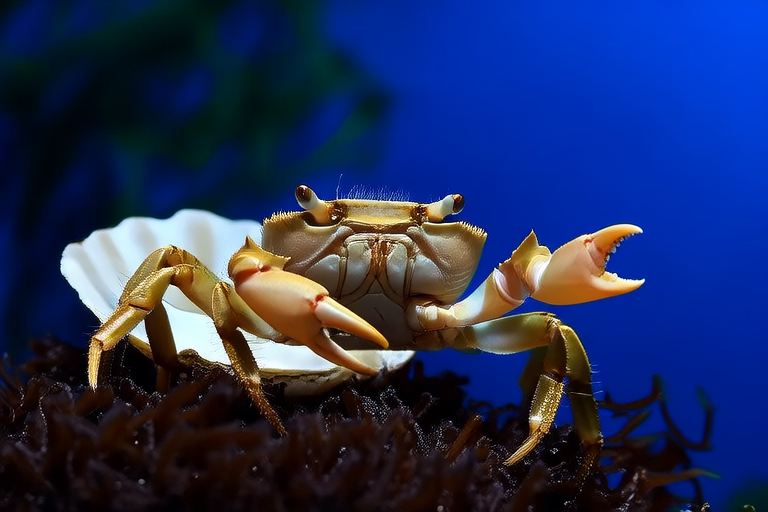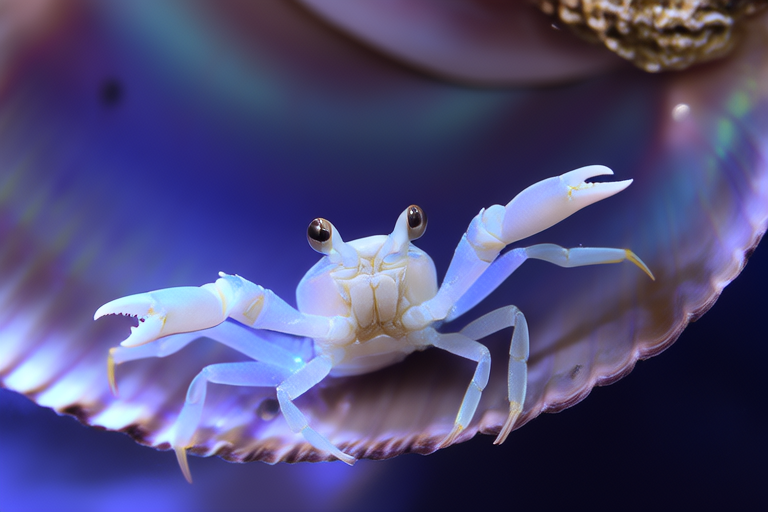
The Intriguing Life of Pea Crabs
Pea crabs, belonging to the family Pinnotheridae, are tiny crustaceans that lead fascinating lives hidden within the bodies of larger marine organisms. These diminutive creatures have evolved unique adaptations that allow them to thrive in challenging environments. From their symbiotic relationships with sea cucumbers and mussels to their reproductive strategies and contributions to marine ecosystems, pea crabs offer a captivating glimpse into the wonders of marine biology.
Unique Adaptations
Pea crabs have developed remarkable adaptations that enable them to survive and thrive within their hosts. Their small size, typically ranging from 5 to 25 millimeters, allows them to fit comfortably inside the body cavities of their host animals. This size also reduces the risk of predation, as larger predators may overlook these minuscule crustaceans. Pea crabs possess flattened bodies, which further aids in fitting snugly within the confines of their hosts. Additionally, they have specialized appendages for clinging onto the internal structures of their hosts, ensuring they remain securely in place despite the movements of their larger companions.
Symbiotic Relationships
The most striking aspect of pea crab biology is their symbiotic relationship with various marine organisms. These crabs are obligate commensals, meaning they rely entirely on their hosts for survival. The most well-known hosts of pea crabs are sea cucumbers and mussels. In these partnerships, pea crabs benefit from the protection and nourishment provided by their hosts while causing little harm to them.
Sea Cucumbers
Pea crabs residing within sea cucumbers can be found in the cucumber’s body cavity, where they feed on nutrients and organic matter expelled by their host. Sea cucumbers are known for their ability to expel their digestive tracts when threatened, a process called evisceration. Interestingly, pea crabs can withstand this dramatic event, remaining unharmed and continuing to benefit from the nutrients released during the evisceration process.
Mussels
Pea crabs that live within mussels are protected by the hard shells of their hosts. They reside in the mantle cavity, where they consume plankton and detritus filtered by the mussel. This arrangement benefits both parties: the pea crabs gain a safe haven and a reliable food source, while the mussels may receive some protection from potential predators due to the presence of the crabs.
Habitat Preferences
Pea crabs are found in a variety of marine habitats, including coastal waters, estuaries, and deep-sea environments. They prefer areas rich in organic matter and suitable hosts, such as seagrass beds, rocky shores, and coral reefs. Pea crabs are often found in shallow waters, but some species inhabit deeper parts of the ocean, where they associate with deep-sea mussels and other benthic organisms. Their ability to adapt to different habitats underscores their resilience and versatility as a species.
Reproduction Methods
Pea crabs reproduce through a process known as external fertilization. Males release sperm into the water, where it encounters eggs released by females. Once fertilized, the eggs develop into larvae that drift in the ocean currents before settling on a suitable host. The timing of reproduction is closely tied to the availability of hosts and environmental conditions, ensuring the highest chances of successful settlement and survival.
Diet and Behaviors
Pea crabs are opportunistic feeders, consuming a variety of food sources depending on their environment and host. In addition to feeding on the waste products of their hosts, they may also prey on small organisms, such as copepods and other microfauna. Their diet contributes to nutrient cycling within marine ecosystems, playing a vital role in maintaining ecological balance.
Pea crabs exhibit fascinating behaviors that reflect their symbiotic lifestyle. They are highly mobile within their hosts, moving around to find food and avoid competition. Some species of pea crabs have been observed engaging in courtship dances, where males perform elaborate displays to attract females. These behaviors highlight the complexity and richness of pea crab social interactions.
Contribution to Marine Ecosystems
Pea crabs play a crucial role in marine ecosystems by contributing to nutrient cycling and supporting biodiversity. By feeding on organic matter and detritus, they help break down waste products and recycle nutrients back into the ecosystem. Their presence within their hosts also influences the behavior and health of their hosts, potentially impacting the broader marine community.
Current Research and Conservation Efforts
Despite their importance, pea crabs have received relatively little attention from researchers and conservationists. However, recent studies have begun to shed light on the biology and ecology of these fascinating creatures. Researchers are exploring the genetic diversity of pea crabs and their evolutionary history, aiming to better understand the origins of their unique adaptations. Additionally, efforts are underway to assess the impact of human activities, such as pollution and overfishing, on pea crab populations and their hosts.
Conservation efforts for pea crabs focus on protecting their habitats and preserving the ecosystems in which they live. By safeguarding coastal and marine environments, we can ensure the continued existence of these tiny yet significant members of our oceans. Public awareness campaigns and educational initiatives are also essential in promoting the importance of pea crabs and encouraging responsible stewardship of marine resources.
In conclusion, pea crabs are remarkable creatures with unique adaptations, symbiotic relationships, and important roles in marine ecosystems. Their small size belies their significance, and ongoing research promises to reveal even more about these fascinating crustaceans. By learning more about pea crabs and taking steps to protect their habitats, we can ensure that these tiny treasures continue to thrive in our oceans for generations to come.





